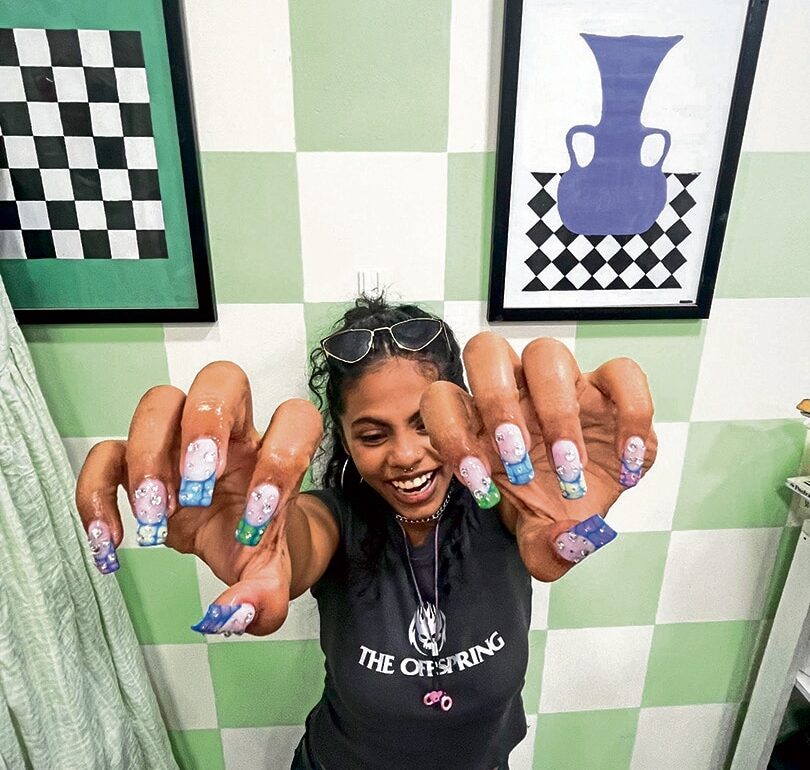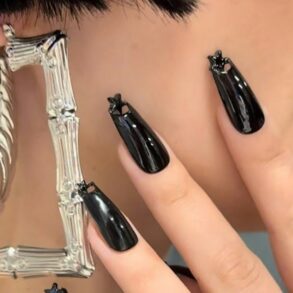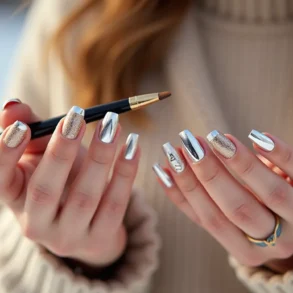“It’s a loop of sorts, where you first go because you want pretty nail extensions (which generally last three-four weeks, depending on maintenance), and then you revisit the salon to remove them, and then you find yourself with a new set.”
Alexander isn’t the only one who’s turned her nails into a canvas of self-expression. Designer Marc Jacobs has been showing off nails as long as fingers on his social media, studded with stones on a tortoise shell bed—a look inspired by a nesting table.
For Delhi-based college student Mira Malhotra, nail art inspiration comes from international celebrities. When celebrity Hailey Bieber announced the news of her pregnancy earlier this year, her almond-shaped nails painted pale pink and adorned with micro cherry blossom flower motifs instantly grabbed Malhotra’s attention. She showed Bieber’s Instagram post to the nail artist at the salon she frequents. “I got them done the same day,” recalls Malhotra, 19, who spent ₹1,500 from her pocket money. A month before, she had got a colourful, upside-down version of French tips (where you paint each nail, leaving the lunula, or the base half moon, in a different colour) and before that, for a college party, she’d opted for a tiger skin pattern in teal blue and black on her nails to add a pop of colour to her otherwise all-white outfit. Malhotra’s upper limit on nail art is ₹3,000 a month. Ask her why she likes to “invest” in her nails, pat comes the reply: “It’s fashion, for nails. Plus, it’s a mini way of telling the world who I am.”
Like all things in fashion and beauty, nail art is constantly evolving. If the French manicure (that timeless white nail polish on the tip of the nails) was trending last season, the most recent trend is of expectant mothers getting their sonogram scans painted on to their nails. You can also get a “ballet slipper” (a nail that resembles the footwear, complete with tapered sides and a square tip) on your fingertip if you have 2-3 hours and ₹7,000-10,000 to spare. When it comes to nail art, there are no aesthetic confines like hair and make-up. The modern manicure, including nail art, is all about blending self-expression with creativity.
Celebrities, of course, have a big role to play in turning nails into elaborate easels. So does social media, where artists and beauty enthusiasts show off their nail-art skills with the tap of manicured fingertips. As a natural extension, the business of nail art is growing in India.
According to a December report from Markets and Data, a market intelligence and business consulting organisation, the Indian nail care market, including nail care products (such as nail polishes and removers, nail art kits and nail care tools) and nail care services by salons, is likely to reach over $2,000 million (around ₹16,600 crore) by 2031 from about $900 million last year. The global nail care market was valued at $23.1 billion in 2023, according to a report by market intelligence company Coherent Market Insights. It’s expected to touch $30.26 billion by 2030. Both reports peg the growth of the nail care industry to increasing awareness of self-care practices among millennial and Gen Z, or post-millennial, consumers, besides the role of social media and celebrities.
Mumbai’s Naz P., 36, falls in the self-care category. The communications strategist started indulging in nail care to stop her chronic nail-biting habit. Now, she spends ₹2,000 a month on her nails “to feel better”. Her personal favourite is mirror chrome nails—where the nails are painted in metallic colours and have a reflective mirror finish—but she sometimes lets her mood or occasion determine her choices. “Some months I just go for the basic nude nail look. When I am on a holiday, I opt for bright colours.”

View Full Image
Fingers talk
It’s this feeling of comfort, freedom, and most importantly, making a statement that’s encouraging people, especially women, to spend close to ₹10,000 a month on their nails—becoming a good business opportunity for salons.
“Nail art has become a significant fashion accessory, complimenting outfits and enhancing personal style. Celebrities and influencers often display elaborate nail designs, setting trends that their followers eagerly adopt,” says Srishti Raai, who co-founded SOEZI, a D2C nail art business based in Mumbai, along with friend-actor Sonakshi Sinha, in September 2022. The core offering of the brand is press-on nails—these are nail extensions across a range of categories, including custom collections, effect (Cat Eye, Chrome, Glossy, Glitter), shape (round, almond, coffin—yes, that’s a thing), length (short, long, medium), colour and occasion—that can be glued on to natural nails using glue tabs or nail glue and removed easily by the wearer. “Press-on nails offer quick and easy solutions for people who want stylish nails and can DIY in less time,” says Raai. An average one-time spend by a SOEZI customer is ₹1,200, and the customers are spread across the country, with Bengaluru and Mumbai as top-selling cities, Raai says.
Smaller salons are seeing a growth in clients as well. Nail by Dev Tanu, a 50 sq. ft nail art studio in a south Delhi market, gets 15 clients a day compared to 10 a month five years ago. “Today, people are getting professional make-up done even if they are going to the birthday function of their neighbour’s kid,” says Rakhi Bouddo, a nail artist and head of the salon. “Covid really taught us self-pampering. Earlier people used to do nail art to flaunt in their friends’ circle and social media. Now, they do it first for themselves and then for others. Plus, women are willing to spend more.” The most popular art at her salon is “Stones” with crystals and sequins, which costs ₹3,000 per finger.
It’s not just society ladies who come to the salon for their manicures and nail work, says a beauty salon manager in Bengaluru, who didn’t want to be named. “I see people across ages and income brackets coming in and splurging ₹4,000-7,000 on nails,” he says. So high is the demand that the salon he works at earns ₹60,000 and above a day, just from nails.
Such a growing demand pushed Bengaluru’s Anthea Lorena Padua, in her mid-30s, to give up her cushy job as a Spanish translator and launch a nail art venture, Anthea Artistry Nail Studio, in 2021. A self-taught artist who learnt the subject off the internet, Padua’s services include Russian manicures (a dry manicure method that uses an electric nail file or drill to remove excessive cuticle skin and shape the nails), and intricate nail art like Japanese kawaii art.
Padua’s 90-plus clients include 20-70-year olds. She charges ₹1,800 for a manicure and nail polish, and ₹3,000 for nail extensions. French tip nail art is charged extra as are adding accoutrements such as charms, crystals, 3D flowers or getting ombre nails. Padua, who describes her work vividly as “painting on 10 little canvases, says, “I follow celebrity nail artists like Tom Bachik and keep track of trends on social media.”
To stay ahead in the game, some entrepreneurs are experimenting with their offerings. Mansi Nagwekar Das, the founder of six-year-old Nailsutra in Mumbai, for example, offers customised press-on nails.
A big chunk of her orders comes from brides, make-up artists, stylists and performers. “I paint nail sets based on their brief,” says Das, 38, a former advertising professional, whose press-ons have been worn by actors like Shobita Dhulipala, Ayesha Kanga and Masaba Gupta. The charges start from ₹1,000 and can go up depending on “how crazy the design is”. “The demand (for nail art) is only growing,” says Das. “It’s just the tip of the iceberg”.
“I don’t think you can shrug it off as ‘just nails’ anymore,” adds Bengaluru’s Padua. “We have an online movement going on called #tagyourmanicurist, which is about giving credit to the manicurist/nail tech along with the hair and make-up artist, whether it’s for big campaigns, red carpet looks, award shows or weddings. Nail work is an art, it can’t be ignored anymore.”
This post was originally published on this site be sure to check out more of their content.









